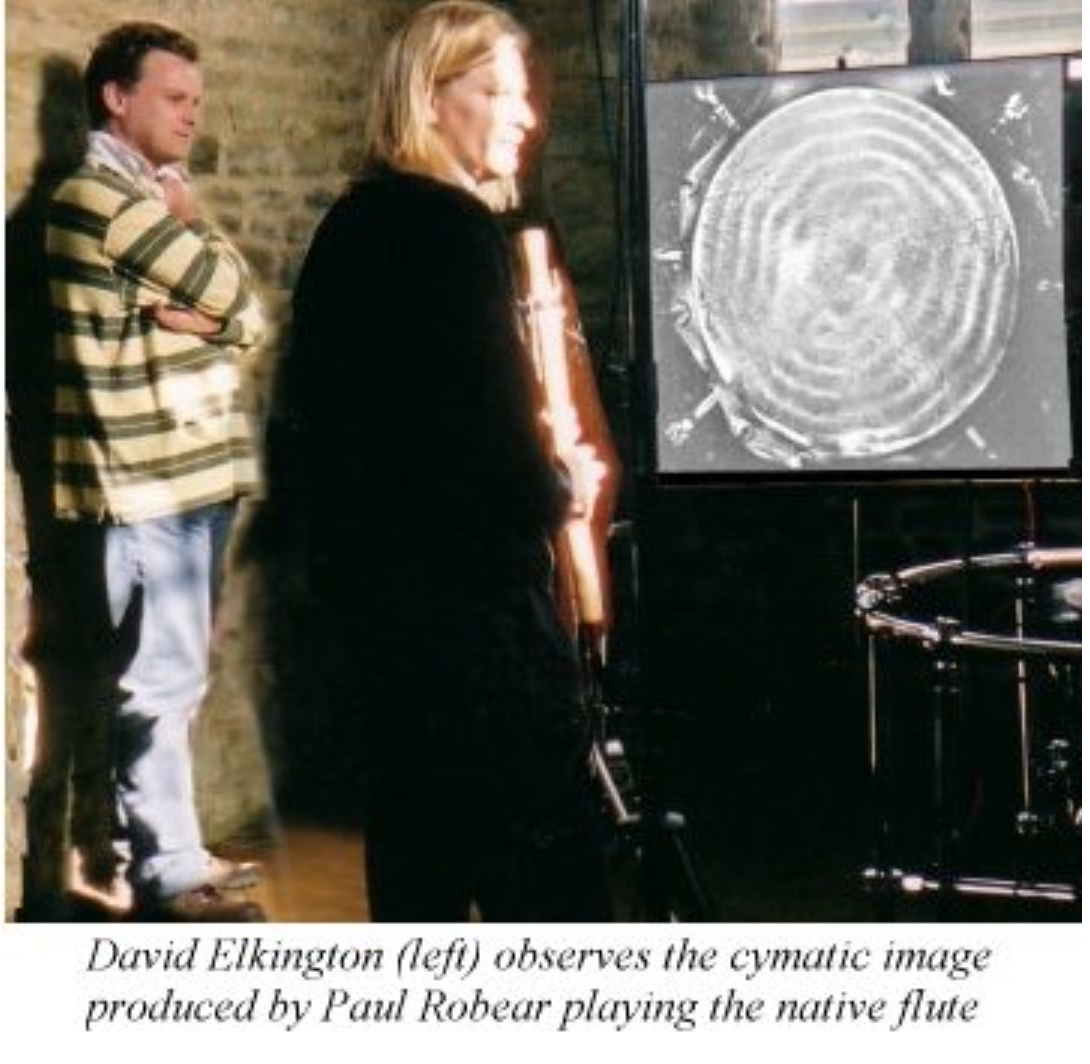
Sacred Soundscape
A 12th Century Chapel Reveals its Sonic Secrets, and a New Theory of Art
by Laura Lee.
“You must come over to England and join us for our next series of cymatics experiments, they’ll be taking place in a 12th Century limestone chapel,” came the invitation. It was the fall of 2002, and I was concluding a two-hour interview with David Elkington on his book, “In the Name of the Gods” about resonance, myth, and language.
We had been discussing how often our current views are often limited by our reliance on the scientific explanation, and how our ancient ancestors should be credited for advanced knowledge that we are only now validating. Knowledge that still stretches our current boundaries, as we play a bit of catch up with the past. “Science would explain hearing sound solely as the interception of sound waves upon the ear, which activate the filaments just inside the middle ear, which is turned into electrical stimuli, producing chemical signals, and experienced as noise,” David had said. “But there are subtle aspects we overlook. I believe that sound conveys much more data than we consciously realize, that we pick this up on some level, and that we can interact directly with this information and energy.”

“So we want to test this idea,” David continued, “to see if there is anything about the phenomenon of hearing that goes beyond those rational explanations. So far, the results suggest that there are, that earth herself speaks directly to us, and that we register this information in symbol, form, language, and myth. To explore how some ancient structures were specially designed for purposeful acoustic results, John Stuart Reid and I have designed a new set of experiments.”
I’d spent the last twelve years exploring what our ancient ancestors knew about, and how they enhanced their experience of, the subtler realms. This promised to be a new chapter in that story. Just a month prior, I had interviewed John, an English acoustics engineer doing some daring, ground-breaking work, about his recent cymatics experiment in the King’s Chamber of the Great Pyramid.
A Brief and Partial History of Cymatics
And this followed on the heels of interviews with Jeff Volk, who has kept cymatics in the public eye for decades. Jeff had given us a brief historical overview: “Two hundred years ago, German physicist Ernst Chladni demonstrated how sound could be rendered visible. He strew sand upon a steel plate and then, drawing a violin bow across the edge of that plate, set the plate “singing” with quite an audible tone. The sand immediately responded to this vibration, creating a vast array of intricate patterns on the plate, which changed in response to the frequency and amplitude of the tone. In the 1960’s and ’70’s, a Swiss medical doctor, Hans Jenny used electroacoustic devices to study these phenomena more precisely. He coined the term “cymatics” from the Greek, ‘kyma’, meaning wave, and documented over 14 years of his extensive 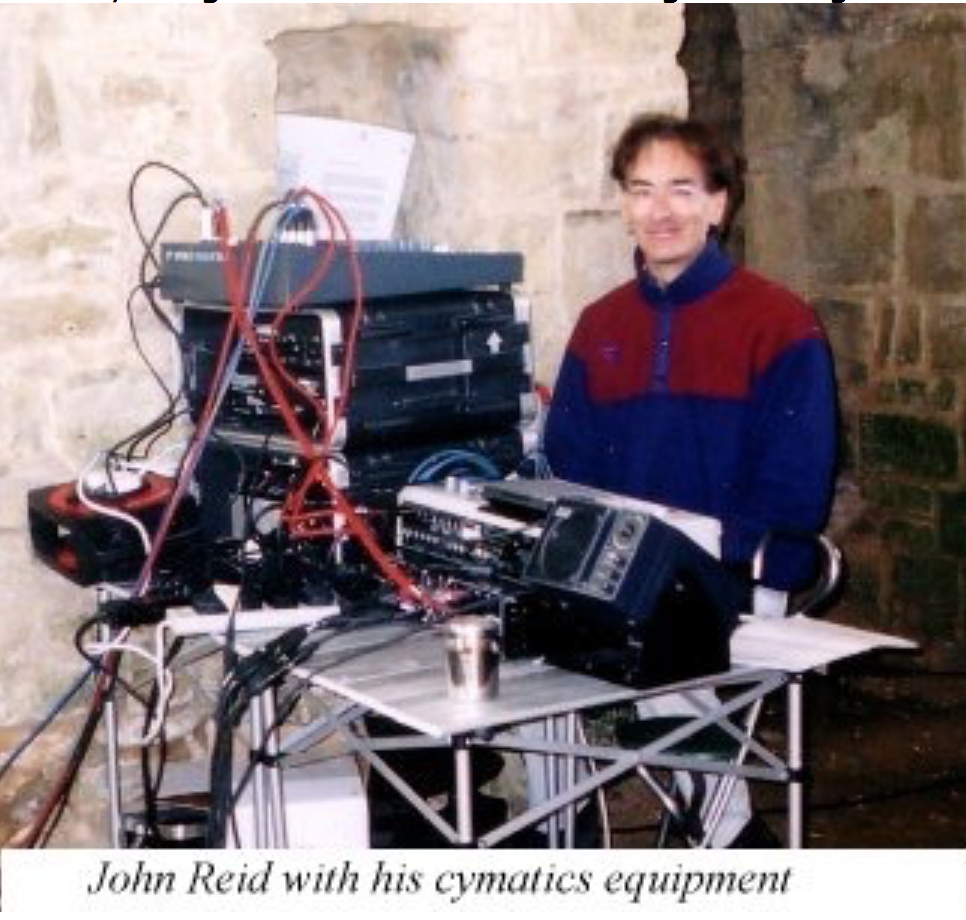 experiments in films, and in hundreds of photographs. He employed a number of materials and modalities to demonstrate the formative power of sound and vibration over inert matter. He used a number of mediums, from laser light bouncing off droplets of mercury, to steel plates dusted with the naturally spherical spores of the club moss, to calcine sand and elastic membranes. All produced beautiful and intricate patterns, and made visible the vast and mysterious world of sound, which in a sense, can be said to animate all of manifest creation.” Jeff republished Volumes I & II of Jenny’s book, “Cymatics” in one volume, along with videos that include original footage.
experiments in films, and in hundreds of photographs. He employed a number of materials and modalities to demonstrate the formative power of sound and vibration over inert matter. He used a number of mediums, from laser light bouncing off droplets of mercury, to steel plates dusted with the naturally spherical spores of the club moss, to calcine sand and elastic membranes. All produced beautiful and intricate patterns, and made visible the vast and mysterious world of sound, which in a sense, can be said to animate all of manifest creation.” Jeff republished Volumes I & II of Jenny’s book, “Cymatics” in one volume, along with videos that include original footage.
A Cymatic Surprise in the King’s Chamber
John had told us how he arrived in Egypt in 1997, well prepared to conduct cymatic experiments on-site. He knew he would have limited time in the King’s chamber, and that he’d need a control to the experiments. So he first constructed a plywood box in his lab, in the exact dimensions of the granite sarcophagus, and rehearsed all the procedures. He set a speaker inside the plywood box, stretched a PVC membrane over the top, and sprinkled on some quartz sand. Then he fed in various tones from an oscillator to see what patterns might emerge.
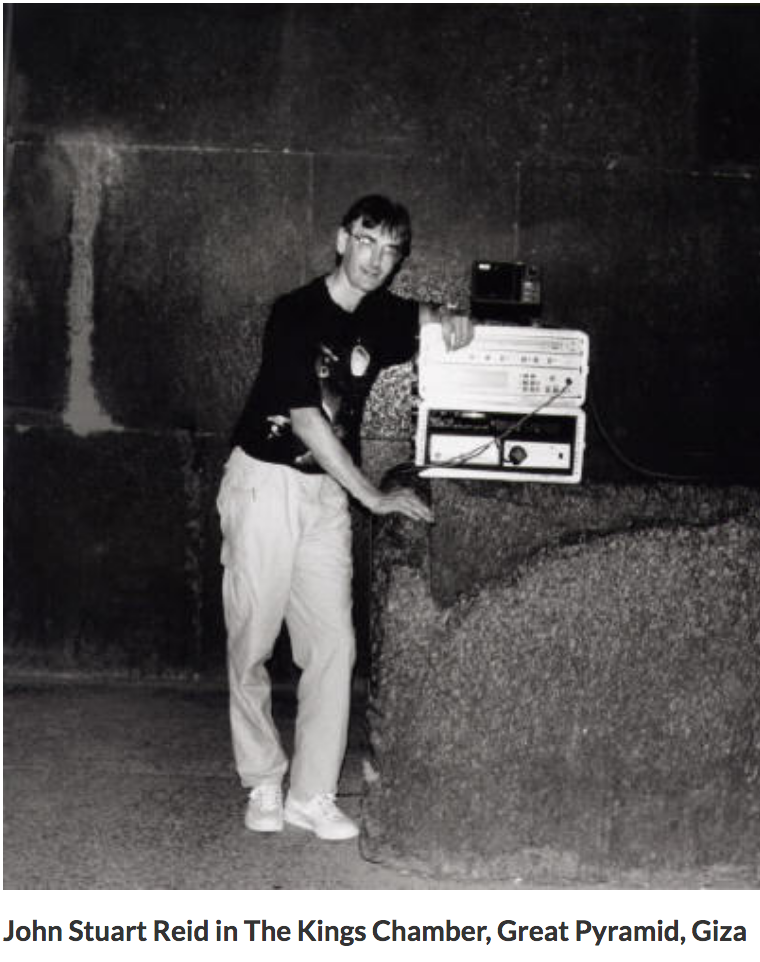 “Whilst the wooden box exhibited only a single set of longitudinal striations,” John explained, “the granite sarcophagus produced some great surprises: cymatic imagery that strongly resembled hieroglyphs. As the images formed on the membrane, I realized that I was the first person in history to see them — with the possible exception of the ancient Egyptians! This was a very great privilege”.
“Whilst the wooden box exhibited only a single set of longitudinal striations,” John explained, “the granite sarcophagus produced some great surprises: cymatic imagery that strongly resembled hieroglyphs. As the images formed on the membrane, I realized that I was the first person in history to see them — with the possible exception of the ancient Egyptians! This was a very great privilege”.
Back at the hotel, John ran into David and shared his images. They soon set about trying to explain such surprising and intriguing results. Says David, “I recognized every one of them as hieroglyphs, and symbols of various of the Egyptian gods associated with the Great Pyramid. I feel that somehow, the internal sound of the Pyramid was manifesting in these most extraordinary patterns, and that ancient observation of the internal sounds of the pyramid brought about the formation of early language. Perhaps this is why most monumental architecture at the outset of most of the ancient civilizations was pyramidal and most of the early languages were hieroglyphic in form. John’s theory is that, via a process of ancient ritual, the hieroglyphic sounds have been encoded into the sarcophagus and that this is what appeared when he did his experiments.”
Seeing Hidden Patterns
And that got them both wondering: If cymatics can reveal hidden patterns, special to that place, and their incorporation into the local art and language, what about other chambers at other sites? What might be in their own backyard, full as England is, with temples left by people well versed in earth energies? They began the search for promising test sites.
And I had to ask, why would the materials and the dimensions of an enclosure affect the way sound moves about and vibrates, as revealed by these cymatic tests?
John explains it thus: “Without building an acoustic isolation enclosure around the sarcophagus, I am unable to quantify how much influence the acoustics of the chamber has on the patterns I captured on film. However, experience gained with my apparatus in a variety of locations has shown that standing wave energy in a given space, can have a significant impact on the patterns which form. The type of stone employed also plays an important part in the process. For example, the King’s Chamber is constructed in granite, as is the sarcophagus. The quartz content of granite is high and quartz exhibits harmonic resonance properties when excited by a pure tone, whether from an oscillator or from a human creating overtones. When excited it gives off its own harmonic ‘signature’. I believe that it is the cumulative signature of countless fragments of quartz imbedded within the sarcophagus and within the chamber walls/floor/ceiling, which are responsible for the images I captured.” John’s book, “Egyptian Sonics” details the whole story.
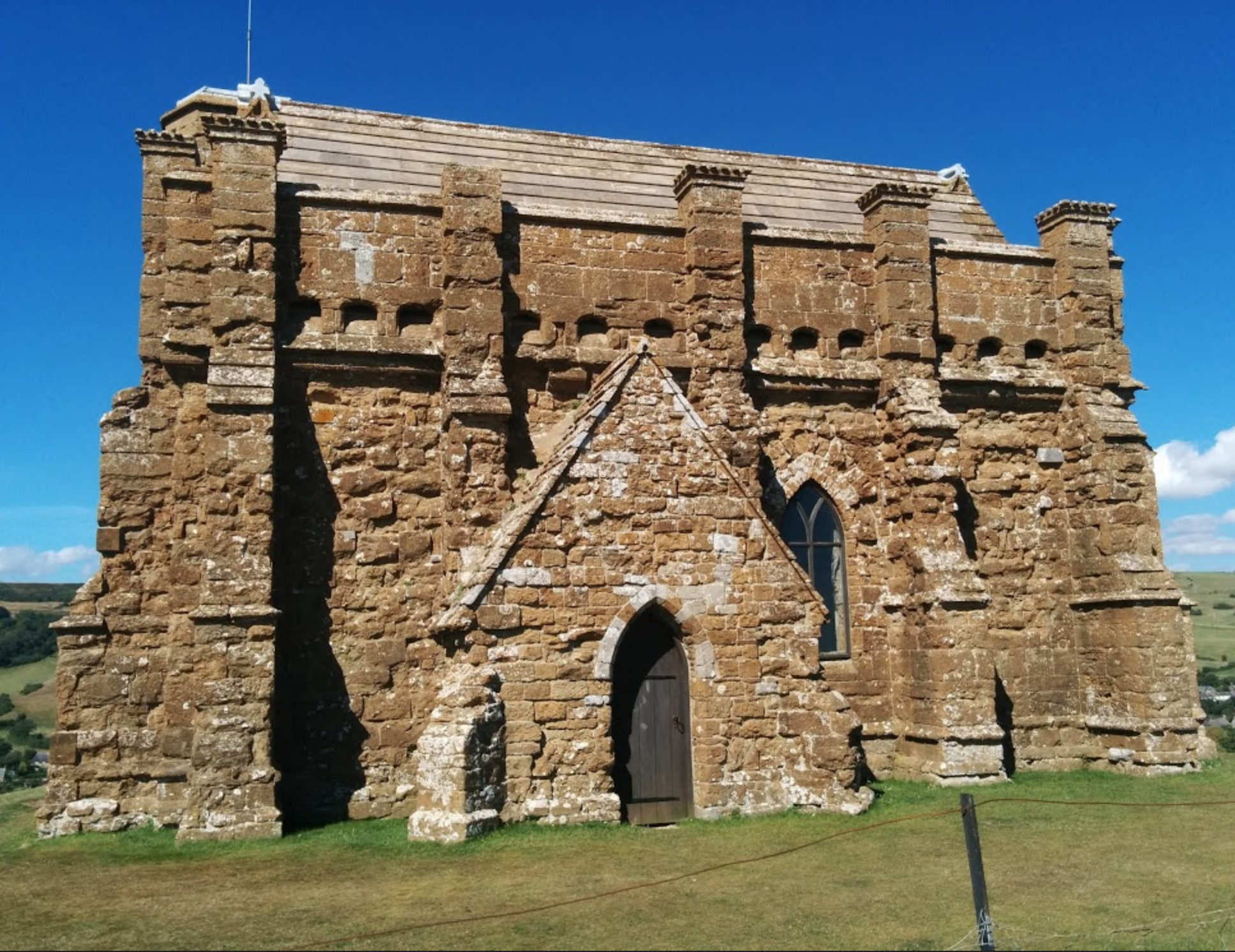
A 12th Century Chapel Reveals her Secrets
Attending their next set of experiments was not an invitation to pass up so Paul and I were soon flying to London. We arrived just in time for this new experiment, coordinated by Clive and Linda Greenslade at a small chapel dedicated to St. Catherine, in Abbottsbury, Dorset. We got the backstory on why this tiny chapel, sitting quite alone on a hill by the sea, surrounded by grassy fields, was the chosen site for this experiment. It’s one of the few chapels of its day left intact, having escaped the fate of so many churches that were reduced to ruins as King Henry the Eighth forcibly removed Catholicism and installed a new, divorce-lenient Church of England. This chapel was spared as it sits atop a hill overlooking the Atlantic, thus serving as an essential navigational landmark for ocean-going vessels with a light kept burning in its top turret. And for David and John, it was it’s Templar connections that made it ideal for the sound experiment. The Templars were steeped in the ancient science of sacred geometry, and built according to its principles. It’s not often you find rooms designed in sacred proportion, like the King’s Chamber of the Great Pyramid, and like a Templar Chapel. Here, sound waves would ring true.
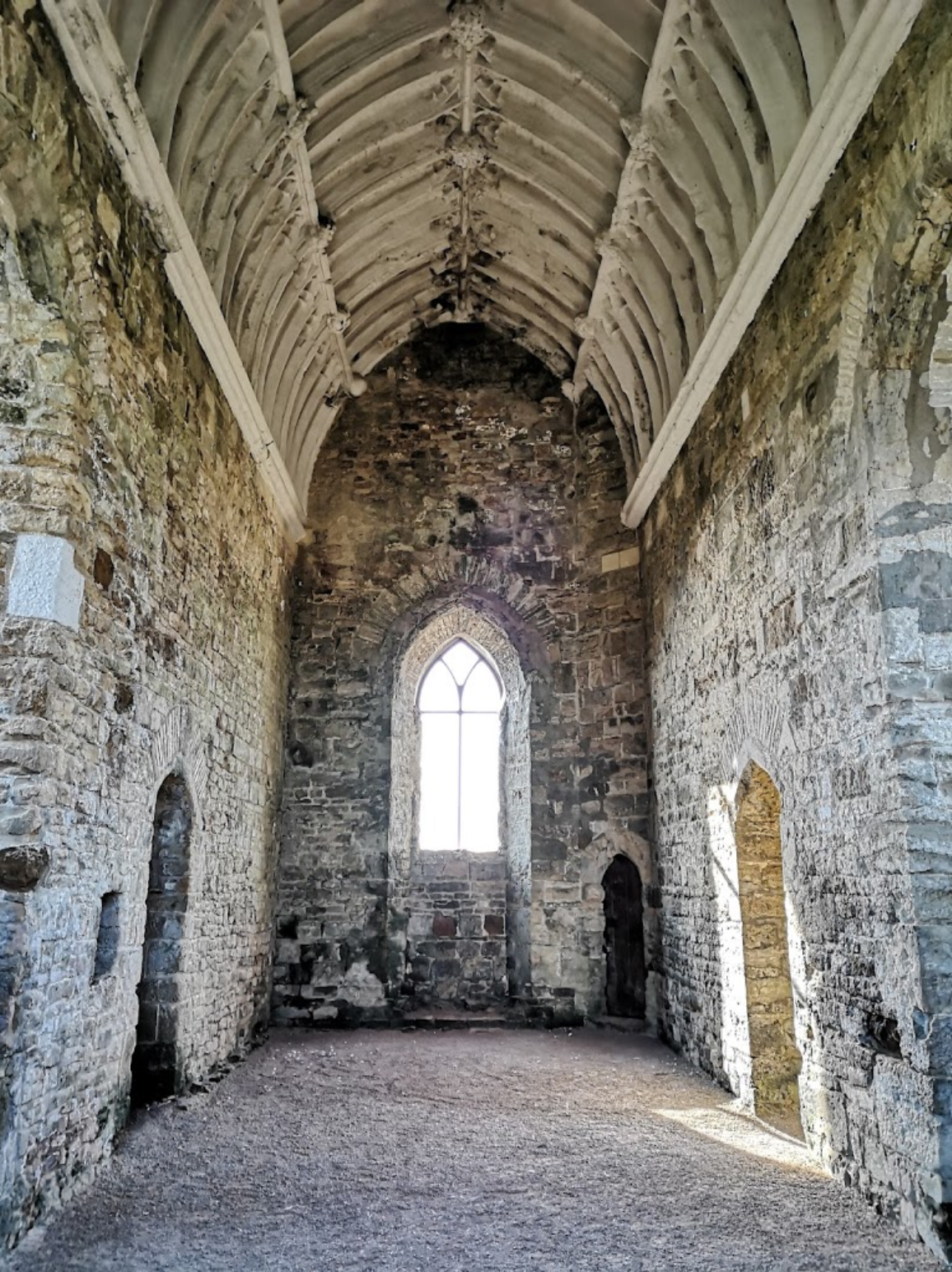 A former priest, well versed on the saints, David shared St. Catherine’s story. “In the Christian tradition she was a supposedly fourth-century saint who lived in Alexandria. She was a learned woman of the mysteries, with connections to the Coptic saint, to Isis, and to the later heretics, the Cathars. She was martyred on a wheel, and her name in Greek means “pure.”
A former priest, well versed on the saints, David shared St. Catherine’s story. “In the Christian tradition she was a supposedly fourth-century saint who lived in Alexandria. She was a learned woman of the mysteries, with connections to the Coptic saint, to Isis, and to the later heretics, the Cathars. She was martyred on a wheel, and her name in Greek means “pure.”
The chapel’s design is unusual, taller than it is wide. The tiles that once made up the floor are gone, leaving only packed earth. There are no pews, no altars, no wall decorations, just a bit of white plaster amongst the bare, unadorned blocks of limestone. Joseph MacDermott, an art restorer, lecturer in the Western Esoteric Tradition, and choir master, suggested its thick stone walls may contain empty clay pots, imbedded at intervals, to further enhance the acoustics with internal resonant chambers. About 40 people arrived to witness and participate in the day’s experiments. John noted that this many people compromised the results somewhat, as our clothing and soft body tissue absorbed sound waves. But this day was also designed as a group experience.
As we waited for the various musicians, singers, and overtone singers to arrive, one woman told me how she had visited a few months prior and found the chapel empty. For some reason, she said, she was moved to tears, not of sadness, but of a palpable sense of the fullness of Mother, of home. This would prove to be a common experience.
So perhaps the storm that raged the previous night was appropriate. There was some discussion, but no consensus, as to whether the acoustic effects would be enhanced or hindered by the weather. David felt that strong winds can strip your personal energy field, with a negative ionizing effect and that this would be good for the day itself. John was concerned that the howling wind would adversely affect the natural acoustic signature of the chapel. Joseph wondered if the porous stone walls, soaked with rain, would vibrate with better effect to the winds. Those were gale force winds that nearly blew us off the hill as we clamored up, and gave John’s truckload of equipment a bad shaking in the farmer’s tractor hired to ferry it to the top.
John’s cymatic gear, comprised of computers, drum, microphones on stands, large projection screen, and an armory of equipment I could not name, filled one end of the small chapel. This was the full-tilt, elaborate set-up not allowed in the Great Pyramid. The musicians were lined up at microphone, wired to carry the vibrations of voice and instruments over to a small speaker set beneath the tightly stretched, horizontal membrane of a drum which John dusted with fine quartz sand as a revealing medium, to make visible the vocal and musical sounds that were planned. A camera aimed at the drum head sent the image to a wide screen positioned to one side of the musicians. When satisfied all was in place, John motioned the first of the overtone singers to the mic. Joseph served as conductor. For the first several singers, the sand collected into simple circles within circles. Soon enough, though, Joseph seemed to know what tones were needed, with a wonderful ability to identify and remember pitch. As he guided the singers as to what notes to hit, complex patterns began to emerge onscreen.
 Then came the beautiful, hi-pitched toning from Chloë Goodchild, internationally celebrated singer, composer and educator, producing a series of more tightly packed concentric circles, like the ripples in a pond when dropping in a stone. Chloë commented, “It was fascinating to collaborate with this entirely new cymatics experience with vocal sound. I remember being aware of an unearthly sound rising up and through my body, freely, spontaneously moving from primordial depths then sweeping up into the ethereal heights and focusing there in the higher frequencies. Of the several responses to my sound I remember that there was reference to it having connected with the masculine-feminine energies of the land and peoples, prior to the building of the church itself.”
Then came the beautiful, hi-pitched toning from Chloë Goodchild, internationally celebrated singer, composer and educator, producing a series of more tightly packed concentric circles, like the ripples in a pond when dropping in a stone. Chloë commented, “It was fascinating to collaborate with this entirely new cymatics experience with vocal sound. I remember being aware of an unearthly sound rising up and through my body, freely, spontaneously moving from primordial depths then sweeping up into the ethereal heights and focusing there in the higher frequencies. Of the several responses to my sound I remember that there was reference to it having connected with the masculine-feminine energies of the land and peoples, prior to the building of the church itself.”

Next up was Paul Robear, who brought along his Native American red cedar flute. As he played into the mic, there emerged a pattern closely resembling the classic Neolithic Cretan labyrinth, complete with the “seam” along one side, with one edge extending just a bit beyond the other where they meet, just as it’s seen on rock art. “I always say that I don’t play the flute, I pray the flute,” says Paul. “I’ve always felt that the flute gives voice to our early ancestors as we find flutes are among the earliest instruments, and we are tuned so simply to sacred geometries and proportions through what sounds right and pleasing to the ear. Music is such a natural and innate avenue to tuning our own frequencies to Nature. Giving visibility and validation to this was thrilling.”
And so the day continued, as Mandalic patterns danced, dissolved, and reappeared, only to rearrange themselves, unique to each voice, each instrument. Joseph and David interpreted many of the patterns, finding correlates in art and myth. We all concurred that the most unusual cymatic pattern resembled an abstract drawing of a woman kneeling in prayer. An oft-recurring pattern was a maze of concentric circles. “A common symbol for the world, for the feminine mysteries,” Joseph pointed out. Sacred site researcher and tour guide Gary Biltcliffe noted that like many tors, the sacred hills in England, the narrow ancient path up to the chapel wound upward around and around in the concentric circles of a labyrinth, with the maze a commonly found scribed in stone and ancient art. John said that many of the patterns made visible that day were unique, not seen by him over many years of cymatic work. He was particularly intrigued by a recurring rose, a circle surrounded by petal forms, which he identified as the result of a standing wave pattern set up between the lengths and widths of the room. Interesting that the rosette is a common motif seen in many churches of the period and elsewhere, noted David, who was also surprised and delighted to find how well this chapel resonates with the female voice. “Most gothic cathedrals are tuned to the male voice,” he said. “But this chapel accommodates both male and female ranges. So it is fully in line with the feminine aspects of a chapel dedicated to a female saint, and with an old folk custom: For centuries, village women would pray at this particular chapel for a husband, for the happy union of male and female.”
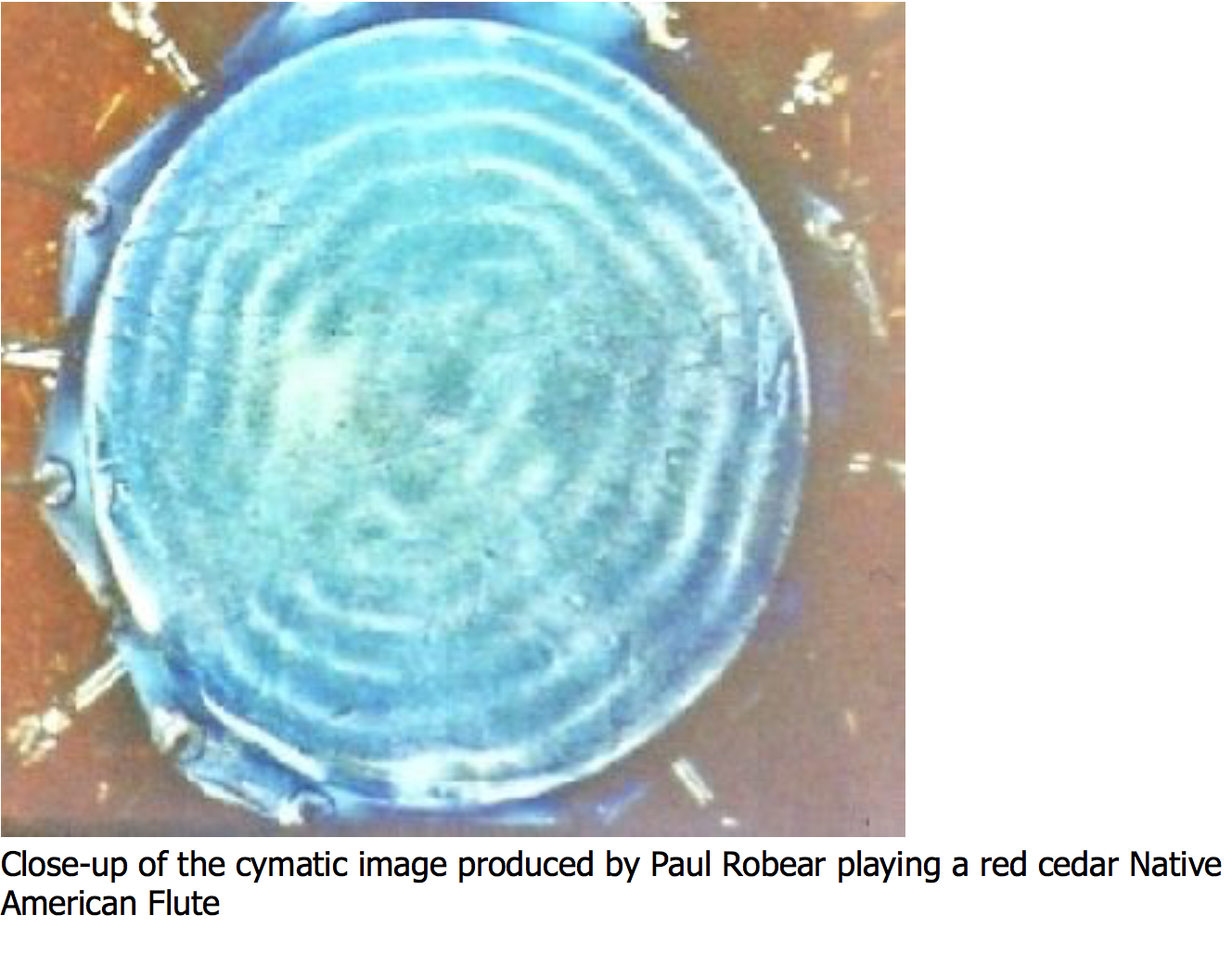
These labyrinth designs are a surprising match to the emergent cymatic design.
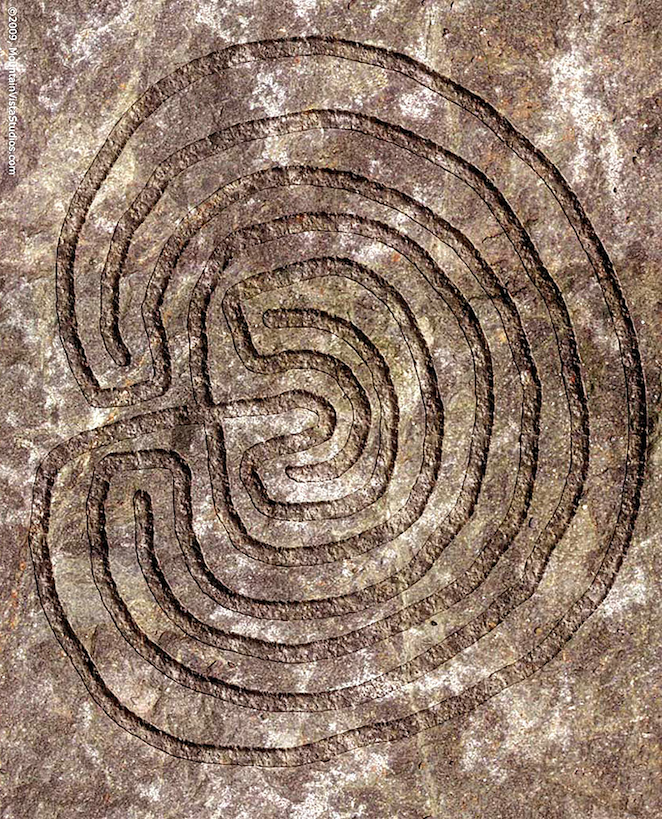
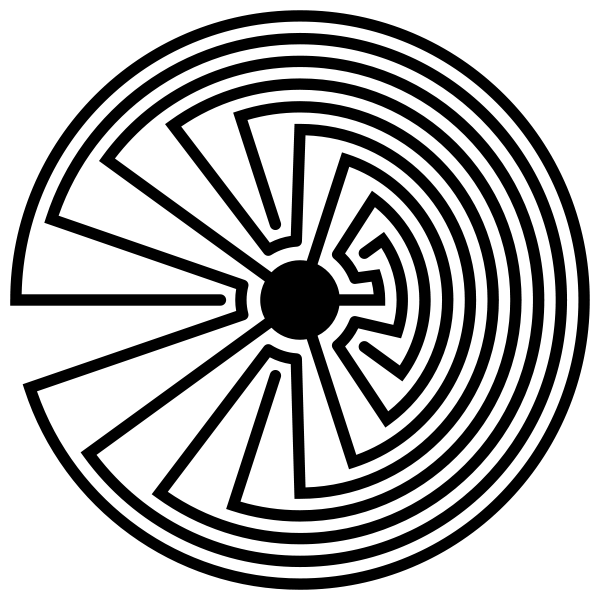
Walking Through the Null and Node
Then came John’s ‘Wall of Sound’, as much experiential as experimental. As John explains it, “this experiment consists first of identifying the prime resonant frequency of the chamber using a Pink Noise test, which I carried out last time I was there. The frequency is near to 125 Hz, very close to that of the King’s Chamber. I then set the oscillator to produce a 125 Hz sine wave and I pumped this out via a small loudspeaker, propagating longitudinally. The sonic energy goes out into the chamber and stabilizes into a matrix of standing waves. If you could see this matrix it would look like a bit like a chessboard with areas of great intensity of sound (the anti-nodes) and areas of low intensity sound (the nodes). However the ‘chess board,’ in this instance, is in 3D so the pattern repeats right up to the ceiling. A pair of stepladders would prove that!”
John had us all line up and slowly walk in procession around his Wall of Sound. You could actually feel the cymatic matrix in 3D. It’s one thing to see the pattern, the null and node lines of a sound wave, on a flat drum, and quite another to feel it surrounding you in space: Take a step, pause, feel your whole body vibrate. Take the next step, pause, and feel the contrasting silence. Continue all around the chapel, feeling the invisible lines of energy, stop and start, stop and start, vibrating your body and senses just as it did the drum head. I could now well understand how the cymatics patterns emerged, as the sand was pushed away from the active anti-nodes to find safe haven in the silent, quiet nodes.
For John, the pattern that emerged during this phase was a key, as he explains: “The amplifiers feeding into the membrane were turned off, yet what we saw form on the membrane looked like a primordial cell with nucleus, ectoplasm etc. The ‘cell’ formed without any direct energy being pumped into the cymatic drum! The energy was indirect. This is absolute proof of how much effect the chamber itself can have on a cymatic image.”
The day finished with a series of songs, known as keening, that had much of the room in quiet tears, and demonstrated that the most powerful instrument of all is the human voice. Linda Greenslade shared her experience: “At funerals, keening allows the mourners to lament for their loved one by bringing out the longing and the separation through haunting melodies. At weddings, keening celebrates the new love, which connects each with the other through harmonious song that rejoices and reconnects. And at St Catherine’s, when the singers came together, harmonizing around the one note that resonated with the building, I felt a deep connection with all mothers. First as a child, going to my mother to be embraced by her unconditional love for me, then as a mother, myself being the one to give out the love to my children and them to me. I felt I knew the mother in the earth whom we had reawakened by being together on that day. Finally, I understood that a mother’s love is a reflection of divine love, the unconditional love of the eternal parent. Reconnecting with the female spirit that had been given the name of Catherine, was a stage along the journey to find that unconditional love once more. For the deep joy of this experience, I wanted to weep from the very essence of my femininity.”
I can still feel the energetic stirrings that a procession, circling slowly up the hill, while chanting, could activate in the land of ley lines. Perhaps in a building ‘tuned’ to both male and female voices, Earth’s meridians below might run with both male and female energy, in balance, intertwined. A potent spot, then, for the village women, and perhaps men, too, to ask for balance, for completion, for divine blessings in all its many guises.
As we all packed up and headed back down the hill, to find that a brisk, brusk day begun in storm was ending with clear, calm, sunny skies, I had to wonder what we might have stirred up. We too made music, as we paid our respects in attention and appreciation — for the land, the sea, the sky, the ancestors, their wisdom traditions, and for its revival. For a chapel sacred in both purpose and proportion. For a glimpse into Nature’s hidden patterns, to see it writ with sand in moving mandalas, as fleeting as the wind on water.
How did our ancestors through the ages, see these and other patterns? Consciously or unconsciously? Or both? Through instinct or osmosis, through our innate sense of pattern recognition, a sense of what is right, good, and pleasing to the eye? Through looking through those inner eyes that open to other realms, in trance states? Surely, as we see in the geometric patterns repeated again and again throughout the ages, through all cultures, in rock art and cave art, and in our own work with Ecstatic Trance Postures, that sacred ecstatic state, so easily and naturally and universally achieved, is a common connection for the worlds’ wisdom traditions. It’s where we readily see the patterns that shape us and everything around us from macro to microcosm, Earth to Cosmos, a deeply embedded primal language by which we speak with the Universe, and with all our ancestors. To see through their eyes, their worldview, is to join in the conversation in that sacred, universal language, Nature’s own. They knew how to activate and fine tune that frequency, to dialogue with Nature directly. This is the language through which we can now read and reclaim our lost history, this is the dialogue our ancient ancestors had with Nature, and Nature is now having with us, an eternal tale of who we were, who are are, and where we are going. Let it help us mark our path as we navigate our arc of the spiral.
My theory on how the hieroglyphs manifested on the sarcophagus membrane is based on the fact that the town in Egypt, called Nekhen (later called Hierakonpolis by the Greeks), where the hieroglyphic language was first developed, also happens to be where the ancient Egyptians first worked granite. According to published Egyptology, the date of these two events is centred around 3,200 BCE. We could look upon the correspondence of these two events as purely coincidental but there is a far more intriguing possibility. When Aswan granite is worked with tools it rings like a bell, due to its high quartz content, so let us imagine a gang of men preparing a block of granite in a Nekhen workshop. A priest-scribe is standing nearby, observing, because his job is to measure how much work each man did, in order that the appropriate amount of salt, grain, beer etc could be ‘paid’ for their labour. (Incidentally, men who had children to feed were paid more than single men). Now imagine that with each strike of the granite, the rich, complex sounds reach the ears of the scribe-priest who is a synaesthetic, meaning that he is one of those rare individuals who sees sounds in the mind’s eye. The sounds he experienced that day, as he is immersed in those complex sounds, create patterns in his mind’s eye that he has never seen before. Perhaps he thinks the patterns have magical properties, so, he quickly sketches them on his tablet, thinking they could become useful symbols in the new written language that he and his fellow priest-scribes are developing. Fast forward to 2500 BCE; the hieroglyphic language is now well developed, and it contains those symbols seen by the synaesthetic priest-scribe. In that later era, Nekhen still has a granite workshop and now the workmen are fashioning a block of granite for the Pyramid of Khufu. Fast forward 4,500 years. I stretch a membrane over the sarcophagus, sprinkle on quartz sand, excite the granite matrix with sound from a speaker, and create those same complex sounds and, lo and behold, create those same natural hieroglyphic patterns witnessed by the synaesthetic overseer as the block of granite was being worked over 5000 years earlier. Put simply, granite contains natural resonances, which when made visible, inspired those ancient synaesthetic scribes to create many of their hieroglyphic symbols.
The physics principle that makes this hypothesis feasible concerns the fact that whenever a membrane is excited by sound, it must exhibit a cymatic pattern. Normally invisible to the unaided eye, these patterns are occurring all around us, all of the time, but we are blissfully unaware of them. In the case of synaesthetic people, the brain mechanism that normally mutes the patterns that manifest on their cochleae membranes, exhibits some degree of malfunction, so the people with this type of synaesthesia not only hear sounds, they see sounds too”.
We very much look forward to our visit with John Stuart Reid.
Take a look at his book and his Egyptian studies on his research web site:
https://www.cymascope.com/cyma_research/egyptology.html
This Sunday, we’ll ask David to further elucidate on his early work with Earth’s resonant frequencies, sacred sites and human consciousness, and why he too believes that early writing was a response to the sound patterns found at sacred sites. He hints that the our brains’ alpha waves in particular are tuned to Earth’s frequencies, and that sacred sites were expressly tuned to specific frequencies, with more on the how and why.
